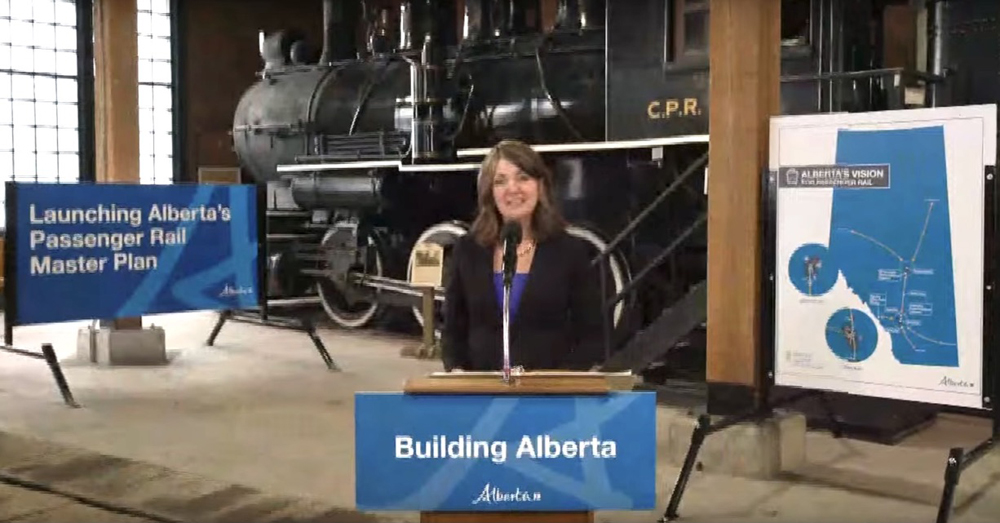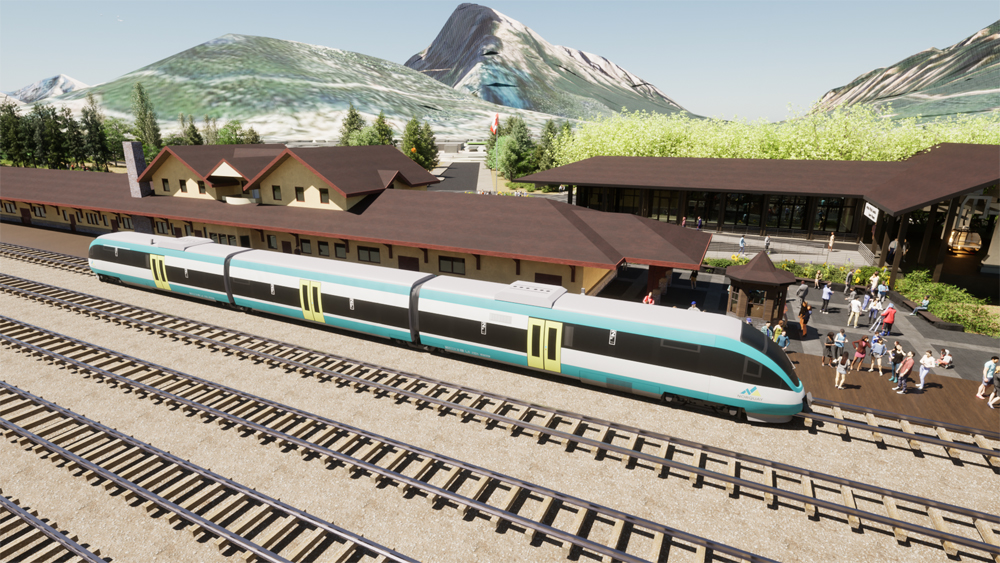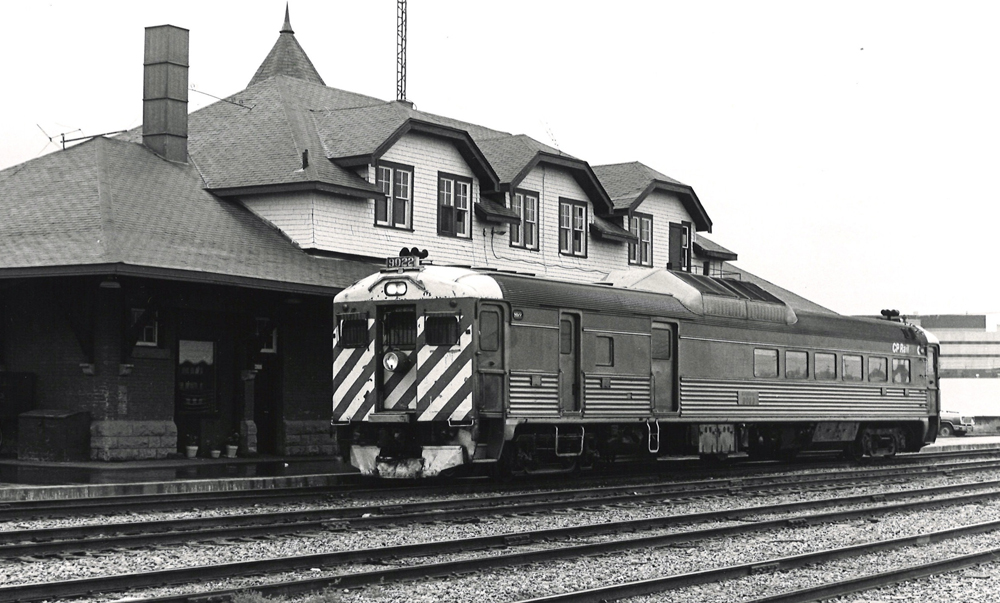
CALGARY, Alberta — The government of Alberta is developing a “Passenger Rail Master Plan” that seeks to create a provincial rail system include a line linking Calgary and Edmonton, commuter rail networks around those two cities, and routes to parks in the province’s mountains, Premier Danielle Smith said in a Monday press conference.
The province has budgeted C$9 million for a study to be completed by summer 2025 to fully develop the proposal, including a 15-year delivery plan with the goal of seeing the projects completed by 2040. The proposal calls for creation of a provincial transit Crown corporation similar to Ontario’s Metrolinx, which would be charged with developing infrastructure, overseeing daily operations, handling fare collection and booking system, addressing system maintenance, and planning for future expansion.
As outlined on the provincial website, the system could feature public or private operation or a hybrid, and would include:
— A Calgary-Edmonton line with a local transit hub in Red Deer, the city midway between the two.
Transportation and Economic Corridors Minister Devin Dreeshen, appearing at the press conference at Calgary’s Heritage Park with Smith, said this would be a high speed rail line, the Calgary Herald reports. The government document on the plan refers to the route as a regional rail line and says it could be conventional or high speed.
— Regional rail lines from Calgary and Edmonton to parks in the Rocky Mountains.

This could include 150-kilometer (93-mile) line between the Calgary Airport and Banff proposed by private investor Liricon Capital, which would use hydrogen-powered trainsets to serve the mountain resort community [see “Proposed Calgary-Banff rail line seeks support from Parks Canada,” Trains News Wire, June 28, 2022]. That $2.6 billion proposal has backing from the Canada Infrastructure Bank, but supporters have complained about a lack of provincial support.
— A Calgary-area commuter rail system serving surrounding communities and connecting downtown to Calgary International Airport, some 17 kilometers (10.6) miles away;
— A similar commuter rail system for Edmonton, including a connection to its airport, 26 kilomters (16 miles) from downtown;
— Municipal-led light-rail systems in Calgary and Edmonton that link with the provincial systems.
Calgary already has CTrain, a two-line, 37.2 kilometer/23.1 mile light rail system; Edmonton LRT isa three-line, 37.4 km/23.2 mile system.
— Rail hubs in major cities providing links between mass transit, commuter rail, and regional rail routes.
“A large and efficient passenger rail network stretching across the province has incredible potential,” Smith said. “It represents a forward-looking vision and is a mobility solution for our rapidly growing province and I’m excited to watch this plan take shape and bring us into the future. There’s a lot of work ahead of us, but I’m confident that we will build the network Albertans need to improve daily life and work, boost the economy and take away the stress of long-distance travel.”
The overall rail network would cost “many billions of dollars,” Dreeshen said, although no more precise cost estimat exists, and no funding mechanism has yet been devised.

VIA Rail Canada last served the 185-mile Calgary-Edmonton route in 1985. The most recent in a series of proposals to revive rail service was 2022’s Alberta Regional Rail, which sought to spend about C$2.2 billion to upgrade the existing Canadian Pacific right-of-way to accommodate express trains that could make the trip in 2 hours [see “Effort seeks to revive Edmonton-Calgary passenger service,” Jan. 31, 2022]. In 2021, Canadian construction firm EllisDon and engineering company AECOM partnered on a proposal for a $C9 billion high speed rail project between the two cities, Prairie Link [see “Canadian construction firm forms partnership …,” News Wire, July 9, 2021]. Little appears to have happened since the initial announcement.
A Liricon Capital official expressed concern that additional government study will further delay the Calgary-Banff proposal.
“The risk is that at the end of the province’s year-long study process to create a master plan for provincial rail, we have studies that sit on a shelf and not projects that are shovel-ready,” Jan Waterous, a managing partner at the company, told the Rocky Mountain Outlook of Canmore, Alta., in an email. “For CABR [Calgary Airport Banff Rail] to advance to construction, the province will need to advance our proposal in parallel with their rail master plan studies.” This, she wrote, would allow the project to secure more than $1 million in funding committed by the Canada Infrastructure Bank. “Without CIB financing, there is no CABR,” she said.
— Updated at 12:10 p.m. CT with photo of VIA Calgary-Edmonton train.














I looked up the combined population of the 2 end points counting their suburbs; it’s probably close to 3M [Red Deer is the 3rd largest city in Alberta but only around 100,000]. So the population appears to be there to support intercity-rail service.
If they can spend 2.2B for 2 hour train service and get it done in 3-5 years that would seem to be the way to go for now.
Am I correct in thinking that the current Route 2 between the cities is what doomed passenger service in the 1980’s?
Where have we heard all of this before? I doubt if we will see 10% of it come to fruition, if that. Millions of dollars for more consultant studies to sit on the shelf.
Well, they hired an artist to make a CGI picture of a train that doesn’t much look like a train. That’s a start.